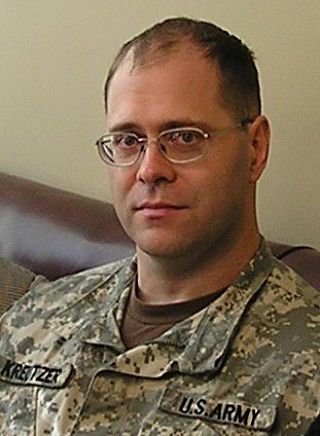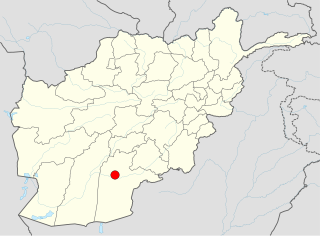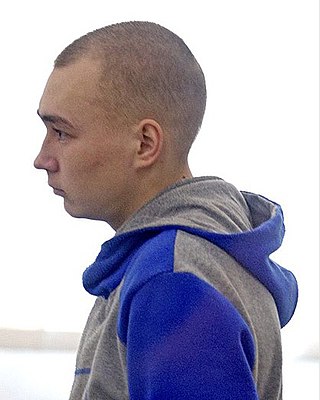
Fragging is the deliberate or attempted killing of a soldier, usually a superior, by a fellow soldier. U.S. military personnel coined the word during the Vietnam War, when such killings were most often committed or attempted with a fragmentation grenade, to make it appear that the killing was accidental or during combat with the enemy. The term fragging now encompasses any deliberate killing of military colleagues.

The United States Disciplinary Barracks (USDB), colloquially known as Leavenworth, is a military correctional facility located on Fort Leavenworth, a United States Army post in Kansas. It is one of two major prisons built on Fort Leavenworth property, the other is the military Midwest Joint Regional Correctional Facility, which opened on 5 October 2010. It reports to the United States Army Corrections Command and its commandant usually holds the rank of colonel.

On July 6, 1999, Barry Winchell, a 21-year-old infantry soldier in the United States Army, was murdered while he slept outside of his barracks by fellow soldier Calvin Glover for dating a transgender woman, Calpernia Addams, after a physical altercation between the two. The murder became a point of reference in the ongoing debate about the policy known as "don't ask, don't tell", which did not allow members of the U.S. military who were homosexual, bisexual, or even transgender, to be open about their sexual orientation.

William J. Kreutzer Jr. is a former United States Army soldier who was convicted of killing one officer and wounding 18 other soldiers when he opened fire on a physical training formation on October 27, 1995, at Fort Bragg, North Carolina. Kreutzer was sentenced to death, but his sentence was later commuted to life in prison by the Army Court of Criminal Appeals in connection with concerns regarding mental illness.

Michael (Stewart) Waddington is an American criminal defense lawyer specializing in court-martial cases, war crimes, and other serious felonies. He defended Sgt. Alan Driver, accused of abusing detainees, and Specialist Hunsaker in the Operation Iron Triangle Case.
John Henry Browne is an American criminal defense attorney practicing in Seattle, Washington. Browne is known for his zeal in defending his clients, his flair for garnering media attention, and for being known as the “plead guilty to avoid the death penalty” lawyer. He has represented defendants in a number of high-profile cases, including serial killer Ted Bundy, Colton Harris-Moore, Benjamin Ng and Martin Pang. He has tried over 250 criminal cases to verdict. Browne and his actions have been the subject of some controversy, and he has sometimes been criticized for his peculiar and combative style both in and out of the courtroom. He is particularly known for obtaining sympathetic treatment for his clients by shifting the focus away from the serious crimes that were committed by arguing for consideration of the background of the defendant and the circumstances in which the events took place.
Dustin Berg is a former member of the Indiana National Guard. In July 2005, he pleaded guilty to fatally shooting Hussein Kamel Hadi Dawood al-Zubeidi, who had been his partner during the U.S. occupation of Iraq. He was sentenced to serve 18 months.
Joshua R. Claus is a former member of the United States Army, whose unit was present at both Iraq's Abu Ghraib and at the Bagram Theater Detention Facility in Afghanistan, and was the first interrogator of Guantanamo detainee Omar Khadr. In 2005, he was found guilty of maltreatment and assault against an Afghanistan detainee who later died.
Members of the United States Armed Forces have violated the law of war after the signing of the Hague Conventions of 1899 and 1907 and the signing of the Geneva Conventions. The United States prosecutes offenders through the War Crimes Act of 1996 as well as through articles in the Uniform Code of Military Justice. The United States signed the 1999 Rome Statute but it never ratified the treaty, taking the position that the International Criminal Court (ICC) lacks fundamental checks and balances. The American Service-Members' Protection Act of 2002 further limited US involvement with the ICC. The ICC reserves the right of states to prosecute war crimes, and the ICC can only proceed with prosecution of crimes when states do not have willingness or effective and reliable processes to investigate for themselves. The United States says that it has investigated many of the accusations alleged by the ICC prosecutors as having occurred in Afghanistan, and thus does not accept ICC jurisdiction over its nationals.
On May 11, 2009, five United States military personnel were fatally shot at a military counseling clinic at Camp Liberty, Iraq by Army Sergeant John M. Russell. In the days before the killings, witnesses stated Russell had become distant and was having suicidal thoughts.

Michael Chase Behenna is a former United States Army First Lieutenant who was convicted of the 2008 murder of Ali Mansur Mohamed during the occupation of Iraq. Behenna is colloquially associated with a group of U.S. military personnel convicted of war crimes known as the Leavenworth 10. He was sentenced to 25 years imprisonment, which was later reduced to 15 years, and served his sentence in the United States Disciplinary Barracks on Fort Leavenworth, a United States Army post in Kansas. He was granted parole on March 14, 2014, after serving less than five years of his sentence. Since his release from prison he has worked as a farmhand. On May 6, 2019, Behenna received a pardon from President Donald Trump.

Forward Operating Base Sarkari Karez was a foreign military base in Maywand District, Kandahar Province, Afghanistan. The base was initially established, secured and named by the 2nd Battalion, 2nd Infantry "Ramrods" in 2008. It was built by the Bravo Company, 62nd Engineer Battalion based in Fort Hood. After President Barack Obama expanded the US presence in Afghanistan, several thousand U.S. Army soldiers were stationed at the base.
The murder of Mohebullah refers to the 2010 shooting of prisoner Mohebullah in Afghanistan by a US soldier who later pleaded guilty and was convicted by a U.S. military judge.

Danny Chen was an American U.S. Army soldier who served during the War in Afghanistan. His suicide resulted in a military investigation and charges against eight US soldiers, ultimately with four being court martialed.

The Kandahar massacre, also called the Panjwai massacre, was a mass murder that occurred in the early hours of 11 March 2012, when United States Army Staff Sergeant Robert Bales murdered 16 Afghan civilians and wounded six others in the Panjwayi District of Kandahar Province, Afghanistan. Nine of his victims were children, and 11 of the dead were from the same family. Some of the corpses were partially burned. Bales was taken into custody later that morning when he told authorities, "I did it".

Robert Bales is an American mass murderer and former Army sniper who killed 16 Afghan civilians in a mass shooting in Panjwayi District, Kandahar Province, Afghanistan, on March 11, 2012 – an event known as the Kandahar massacre.
The FEAR militia was an American terrorist group of between four and eleven individuals that the State of Georgia alleged in 2012 to have planned to destroy a dam and poison apple orchards in Washington State, set off explosives in Forsyth Park in Savannah, Georgia, and assassinate President Barack Obama. Four of the individuals charged were soldiers stationed at Fort Stewart, Georgia. The group killed two people in an attempt to prevent them from revealing their plans to the public. The group used the Army to recruit militia members, who wore distinctive tattoos that resemble an alpha and omega symbol.
Derrick Miller is a former US Army National Guardsman sergeant who was sentenced in 2011 to life in prison with the chance of parole for the murder of an Afghan civilian during a battlefield interrogation. Miller is colloquially associated with a group of U.S. military personnel convicted of war crimes known as the Leavenworth 10. After being incarcerated for eight years, Miller was granted parole and released in 2019. He currently serves as the Executive Director of the Justice for Warriors Caucus and Military Adviser to Texas Republican U.S. Representative Louie Gohmert.
War crimes in Afghanistan covers the period of conflict from 1979 to the present. Starting with the Soviet invasion of Afghanistan in 1979, 40 years of civil war in various forms has wracked Afghanistan. War crimes have been committed by all sides.

Vadim Yevgenyevich Shishimarin is a Russian soldier who was the first person to go on trial for war crimes committed during the 2022 Russian invasion of Ukraine. On 18 May 2022, he pleaded guilty to fatally shooting an unarmed civilian, Oleksandr Shelipov. On 23 May, he was sentenced to life imprisonment. Shishimarin's lawyer lodged an appeal and on 29 July 2022, his sentence was reduced to 15 years in prison. Law professor Chris Jenks suggested that the legal reasoning, conviction and sentencing appeared to be flawed.














